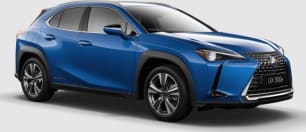As soon as you slide in, you’re reminded that the UX is a small SUV. Even with the driver's seat at its lowest position I still knock my knees on the steering wheel when getting in and out of the car.
The higher door sills also accentuate the penned in feeling despite there being plenty of head- and legroom in the front row!
Then comes the back seat, which is super tight on space. I’m 168cm (5'6") and my headroom is fine but the legroom sucks. My knees press into the back of the driver’s seat (set for my driving position).
There’s also not a lot of space underneath the seat for toes, so I wouldn’t recommend the UX to anyone who regularly transports tall passengers.
Having said that the seats in both rows are very comfortable and the leather trims feel lovely to touch. Both front seats are electric with heat and ventilation functions but only the driver’s side enjoys adjustable lumbar support.
Storage is good throughout the car, which is not usually the case for the small SUV class. Up front you get a glove box, two cupholders, two drink bottle holders and a middle console that opens from both sides, which is handy and cool.
In the rear you get two cupholders in a fold-down armrest and map pockets but no storage bins in either door unfortunately.
Other amenities in the back are very good for this class with the heated outboard seats, directional air vents, reading lights and two USB-C ports.
On that note, the upgraded multimedia system is now easier to use while on the go, is responsive to touch and looks great.
Some of the information on the system can be annoying to find but the customisations available on the 7.0-inch digital instrument panel more than make up for it.
There is a coloured head-up display, wireless Apple CarPlay, wired Android Auto and satellite navigation.
All are easy to use and won’t confuse you too much!
The charging options are great with each row getting two USB-C ports but the front also gets a USB-A port, 12-volt socket and a wireless charging pad. You’re seriously spoilt for choice.
The boot space sits at a small 314L, which is 100L less than the previous model but that’s because Lexus has made a little storage nook underneath the floor for the tyre repair kit and cable pouches.
It's a great boot because it sits high and is easy to access, and I have plenty of room for all of the gear needed for a week’s errands. The hands-free powered tailgate is great, too.

